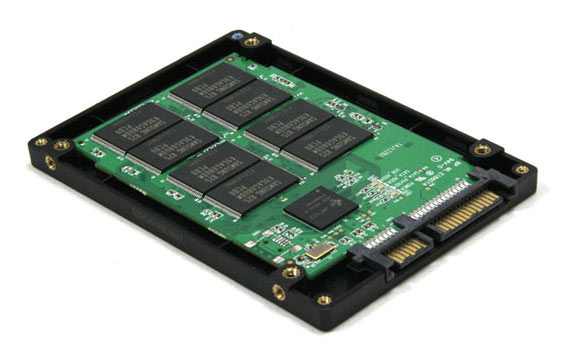Choosing the Storage
What is Storage?
Storage is the place inside a PC where larger amounts of less frequently visited data sets are kept. This includes anything that is either too large or not needed often enough to be allocated space in the RAM. This includes data such as the operating system, games, photos and videos. Almost everything is stored outside of the RAM in this storage. Storage has slower access speeds compared to RAM but it has higher capacities and also lower costs.
 What does storage look like?
What does storage look like?
Storage comes in two almost polar opposite forms. Solid State Drives (SSD's) and Hard Disk Drives (HDD's). The image further up the pager is an HDD with its front panel off. As you can see it has a series of magnetic metal disks with arms sliding between them. There is also a lower portion where there a controller to manage the movement of the lever arm. The tip of the lever is highly sensitive and can both detect and write data onto the disk as it spins at 5200 RPM. Small sections in the drives can be left either 'on' or 'off' (a binary storage system).
 Pictured below the HDD is an SSD. This is a NAND storage flash drive. It composes of a set of storage chips and a microcontroller to manage the data storage. SSD's have no moving parts but they still use the same on/off system as an HDD for storing data from your PC. Both HDD's and SSD's both generally use the same connectors as well. SATA power and data cables have to be plugged in for both drives to work. The power cable comes directly from your PSU and the data cable plugs into a connector on your MOBO.
Pictured below the HDD is an SSD. This is a NAND storage flash drive. It composes of a set of storage chips and a microcontroller to manage the data storage. SSD's have no moving parts but they still use the same on/off system as an HDD for storing data from your PC. Both HDD's and SSD's both generally use the same connectors as well. SATA power and data cables have to be plugged in for both drives to work. The power cable comes directly from your PSU and the data cable plugs into a connector on your MOBO.Which should I get?
There are pros and cons of both SSD's and HDD's.
SSD's are good because:
- They have faster read and write speeds both sequentially and in 4k chunks.
- They will last longer and are more reliable due to a lack of moving parts.
SSD's drawbacks are:
- They are much more expensive.
- Poorly manufactured drives can experience more 'data drops' than HDD's.
- Some cases don't have support for them
HDD's are good because:
- They are much cheaper per Gb and start at lower price points.
- Cases usually have support for multiple hard drives.
- They are prone to breaking after several years of constant use.
- They have slower sequential and 4k speeds.
Which did I get?
I decided from an early stage that the superior £/Gb ratio of an HDD took my fancy. If you buy a HDD from a reliable manufacturer you should not have to worry about horror stories of hard drives breaking soon after purchase. My particular hard drive came with a 2 year warranty which is good. I will be careful though when the end of this period is coming up because it could be a time the drives are prone to loosing data. I am happy with my Western Digital caviar blue 500Gb HDD but it does only operate at SATA 2 speeds which is half the bandwidth of SATA 3. In the future I plan to buy a 250Gb SSD for the OS and frequently opened applications.






